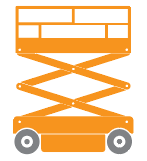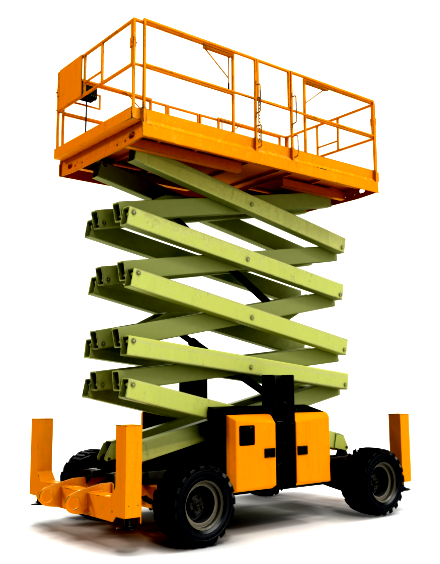Scissor Lifts
What is a Scissor Lift?
A scissor lift is a type of motorized aerial forklift (aka construction lift) that helps workers, such as construction workers, reach elevated heights more safely and easily. Scissor lifts consist of a raised platform that holds workers and their tools and crisscrossed metal support bars, which raise and lower the platform as needed.
Scissor lifts are very sturdy, versatile equipment. Because they can hold weights of up to 2,500 pounds and reach hard-to-reach, elevated heights of up to 60 feet, they are one one of the most commonly used forklifts in the construction industry today.
Where and how are scissor lifts used?
Scissor lifts, like boom lifts, are most commonly used in the construction industry to reach elevated heights. However, they are used in different ways than boom lifts. Scissor lifts can reach a maximum height of around 60 feet while some boom lifts can reach up to 180 feet. Additionally, scissor lifts only move vertically (up and down) while boom lifts’ arms can move horizontally and vertically (up and over). With that being said, if you need to reach heights of up to 60 feet and only need to move upwards, a scissor lift is your best bet in terms of forklift equipment.
Scissor lifts can be operated using either gas or electricity. Take a look at some common industries and applications where scissor aerial lifts are used:
- Outdoor construction sites
- Warehouse (ie. high ceilings and storage)
- Distribution and industrial (ie. deliveries)
- Maintenance (ie. city building maintenance and construction)
- Infrastructure (ie. hanging signs)
- Home renovation and remodeling
- Transportation (ie. trucking, railroad facilities)
- Landscaping (ie. tree trimming)
Types of Scissor Lifts
When exploring different types of scissor lifts, there are two different factors to keep in mind – electric vs. gas-powered lifts and slab vs. rough terrain scissor lifts. Electric vs. gas refers to the scissor lift’s power source – in other words, what fuels the aerial lift and allows it to run. On the other hand, slab vs. rough terrain refers to the work environment where the lift will be used.
Electric vs. Gas Powered
Although most scissor lifts will look very similar, there are two different “engines” they might have – gas or electric. Electric scissor lifts are emission-free and run using a battery. They produce very little noise and are best used for indoor applications or small, narrow spaces
There are also gas-powered scissor lifts, which use an engine that requires diesel gas fuel. As a result, gas-powered scissor lifts do usually emit fumes. However, they typically have heavier duty tires and are better equipped for rugged, wider outdoor areas.
Slab vs. Rough Terrain
You will typically see two different options when it comes to scissor lifts – slab vs. rough terrain. These two options refer to the different terrains or work environments where the forklift will be used.

Slab scissor lifts: Best for indoor jobs or narrow work areas
Slab scissor lifts are designed to function well on slab, flat surfaces, such as concrete or indoor flooring. They are typically electric-powered forklifts and run by using a low emissions battery. While they usually reach lower heights compared to rough terrain lifts (around 45 feet), they tend to be more nimble and versatile. Slab scissor lifts are great for maneuverability and narrow, tight workspaces. You might find a slab scissor lift used in a parking garage, narrow urban area, or retail setting.

Rough terrain scissor lifts: Best for outdoor construction and maintenance
These forklifts are designed to function efficiently on rugged or uneven outdoor terrains, such as gravel or rock. Most rough terrain lifts are diesel gas-powered and equipped with heavy duty tires, four-wheel drive and traction control. They also are better suited to larger or wider work spaces compared to slab lifts, and usually have work platforms with higher weight capacities (1,000-2,500 lbs).
Dimensions and Capacities
When looking for a scissor lift suited to your project’s needs, it’s important to pay close attention to the dimensions and capacities. This includes the foirklift’s maximum reachable height, platform weight capacity, and workspace width.
Scissor lifts will vary depending on the manufacturer and type of scissor lift. Remember that gas-powered and rough terrain scissor lifts usually reach higher elevations and can hold heavier weight on their work platforms. Electric and slab scissor lifts may have relatively lower weight and height capacities.
Take a look at the ranges for height, weight, and platform width for scissor lifts:
| Max height capacity | Weight capacity | Platform Width |
| 19-60 ft. | 500 – 2,500 lbs. | 69-90” wide |
Common Rent vs. Purchase Pricing
Of course, pricing for scissor lifts will vary depending on whether you are looking to rent vs. buy. Rentals are typically charged per day, week, or month, depending on the duration in which you need the forklift. Purchase prices vary depending on whether you are buying brand new vs. used equipment.
| Rental | Purchase |
| Per day: $100-$300 Per week: $350-$500 Per month: $800-$1500+ | $5,000 – $40,000 Depending on type and new vs. used |
| Delivery and pickup: $150 per service |
Influencing factors on pricing
Keep in mind that several additional factors will impact rental and purchase pricing. For instance:
- Electric vs. Gas-powered
- Slab vs. Rough Terrain
- Height and weight capacities
- Location
- Supplier delivery cost
Typically gas-powered and rough terrain scissor lifts go for higher costs compared to electric and slab scissor lifts. Additionally, for the most part, the higher elevation the scissor lift can reach, the more it will cost to rent and buy.
If you are buying, remember that used scissor lifts will cost less than brand new ones. When buying, also make sure to pay attention to things such as the manufacturer, maximum lift height, and weight capacity.
If you are renting, you also want to keep in mind factors such as your geographical location and your supplier’s delivery charges. For instance, if you live in a big city such as New York or Los Angeles, you will likely pay more to rent a forklift compared to more rural areas. Pay attention to how far your supplier is from your location, as more mileage traveled during delivery may hike up your delivery charge.
We always recommend comparing your total rental cost to your potential purchase cost to see which is the more cost-effective option. You can also use our free service to match with aerial lift providers in your area offering the most competitive rental and purchase prices!
